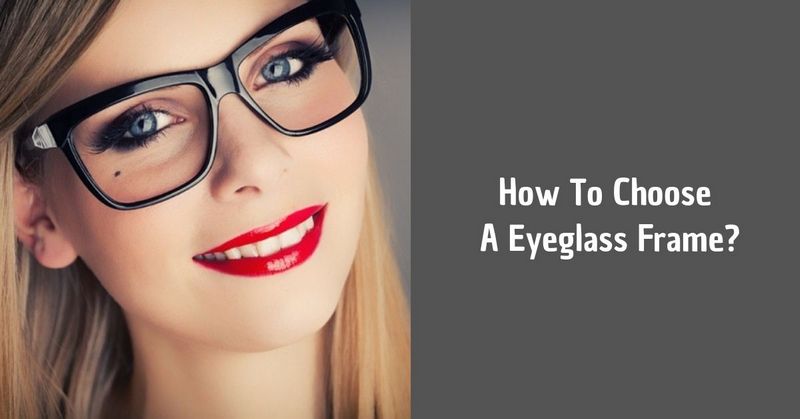How To Choose A Eyeglass Frame?

Eyeglasses are crucial for vision correction and in most cases a person wears them constantly. Therefore, the correct selection of the frame must be approached with full responsibility. Incorrectly selected frames can distort the aesthetic perception of the face and lead to discomfort, headaches, eye strain, eye fatigue, and visual impairment.
How to choose the size of a frame?
Before choosing a frame, you need to know what parameters you should pay attention to. Each frame consists of:
- frames or light openings that fix the lenses;
- ear hooks that hold the structure at a certain distance from the eyes;
- a bridge connecting the frame.
Each element has its own dimensions, which are indicated in the frame on the inner surface of the ear hook (in mm).
Most models do not go beyond the outline of the face, so when choosing a frame, you need to take into account the distance between the temples. The length of the ear hook is calculated so that the distance between the back of the lens of the glasses and the front of the eyeball is 12 mm, with the exception of half glasses.
The length and appearance of the bridge also matter. The main weight of the glasses falls on the bridge of the nose and should be distributed evenly. The product is fixed on the nose with the help of nose pads.
A correctly selected frame should not slide off with sudden movements of the head, squeeze the bridge of the nose and “dig into” the temples.
The importance of size when selecting eyeglass frames
If the frame is incorrectly selected, the patient experiences discomfort:
- dizziness;
- headache;
- pain in the eyes;
- a feeling of heaviness in the nose and pain in the frontal part of the head;
- pressure in the temporal region and pain over the auricle.
The image even with a correctly determined optical power of the lenses becomes blurry, which requires eye strain from the user and leads to rapid fatigue.
Incorrectly selected frames in children under 8 years of age can lead to amblyopia or “lazy eyes.” Prolonged wearing of the wrong frame can adversely affect visual acuity and further impair vision.
How to choose the right frames for your face?
The frame, in addition to functional tasks, also solves aesthetic ones. It should be suitable for the shape and type of the face, decorating it and emphasizing the best features, or balance anthropometric deviations. There are several types of facial contours:
- oval;
- round;
- triangular or heart-shaped;
- rectangular or square;
- trapezoidal.
The shape of the face sets the direction of the search for a specific shape of the frame. So, for example, a person with an oval face can choose almost any kind of frames – from classic to avant-garde.
A round face with soft oval lines requires a frame with a horizontal or almost horizontal upper part, a square-shaped frame that visually balances the outline of the face. We recommend that you pay attention to an expressive, possibly massive frame of contrasting colors.
The triangular face has a wide forehead and high cheekbones with a narrow chin. To balance the narrow lower part of the face, you should choose:
- round or oval frames;
- frames with low located temples;
- frames focused on the bottom of the frame.
The square face has a wide forehead and the corresponding width of the corners of the lower jaw. Rounded frames and a thin light frame visually soften the angularity of the face lines. The ear hooks should be attached to the top or middle of the frame.
In a trapezoidal face, the forehead appears narrow in contrast to the massive broad lower part. People with this type should prefer frames of the form “cat’s eye” and other types that go beyond the face in the upper part and visually expand it. The ear hooks should also be wide to offset the sharp transition of the upper and lower parts.
It is more difficult to choose a frame for an Asian face because of the anthropometric features of the structure of the cheekbones and nose bridge. Some companies create special eyeglass frames for people with this face type.
How to choose the color of the frame?
Before deciding which frame to choose by color, designers recommend determining the color type of appearance. There are 2 warm types – spring and autumn, as well as 2 cold types – summer and winter.
The spring type is characterized by transparent tender skin with a light “honey” tint, a scattering of freckles and soft facial features. Hair can be red to light brown. Therefore, the color of the frame can also be in this color scheme – golden, beige, bluish, red, brownish.
Autumn warm type is characterized by transparent skin and hair color from bright red to black. Frames should be of warm shades: beige, golden, green, brown.
People with the summer type of appearance have muted bright eyes. They should choose frames of pastel colors, and if they have a light olive skin color – gray, violet, indigo, purple frames.
Winter color type requires a contrasting frame of dark or black colors.
The recommendations are relative. You can “break” stereotypes and shock with the shape, color of frames. The main thing is that you feel comfortable!